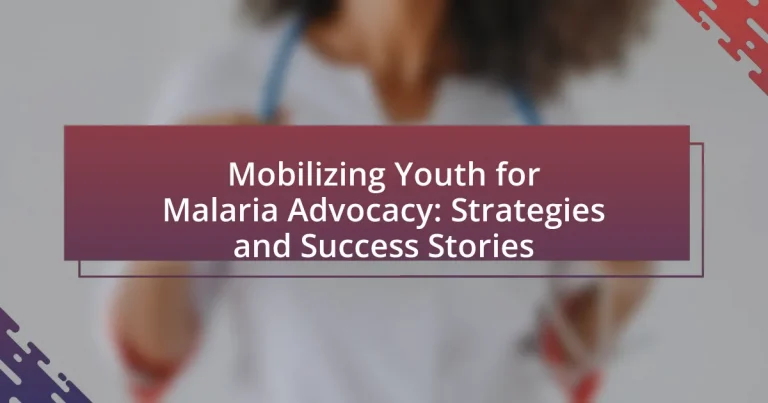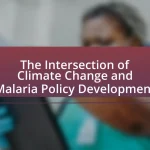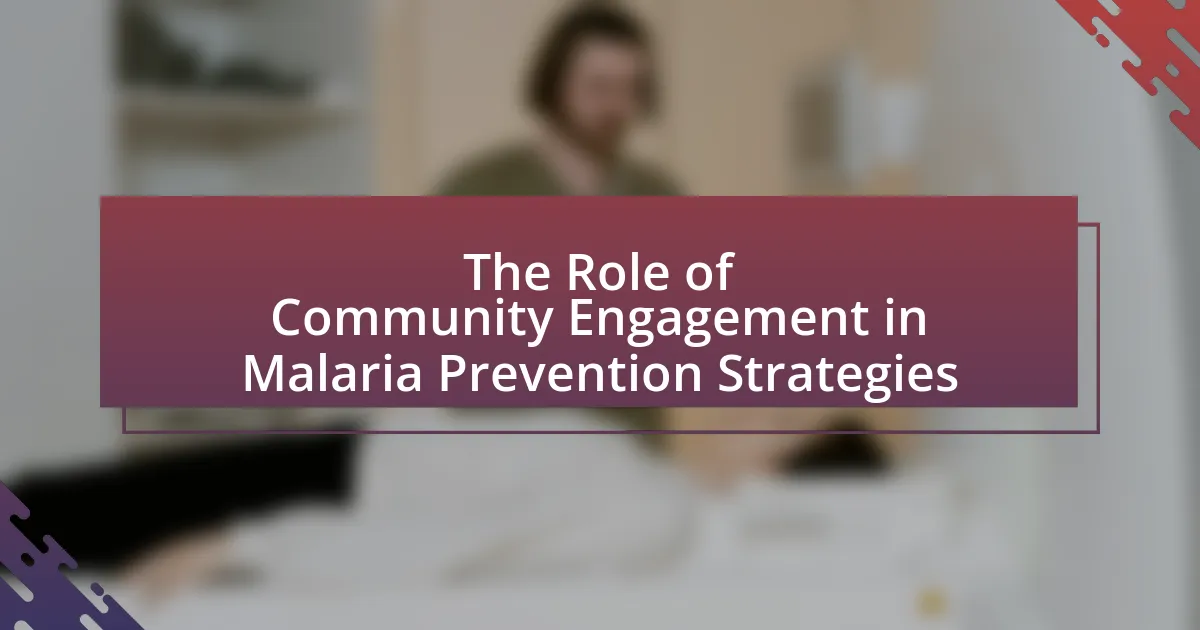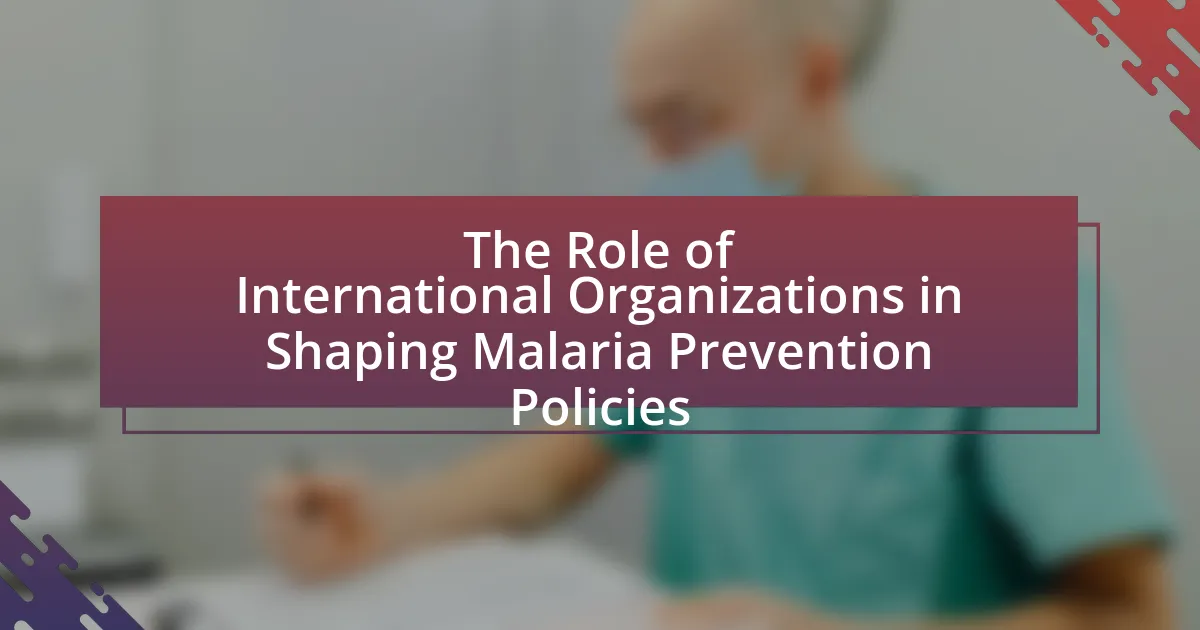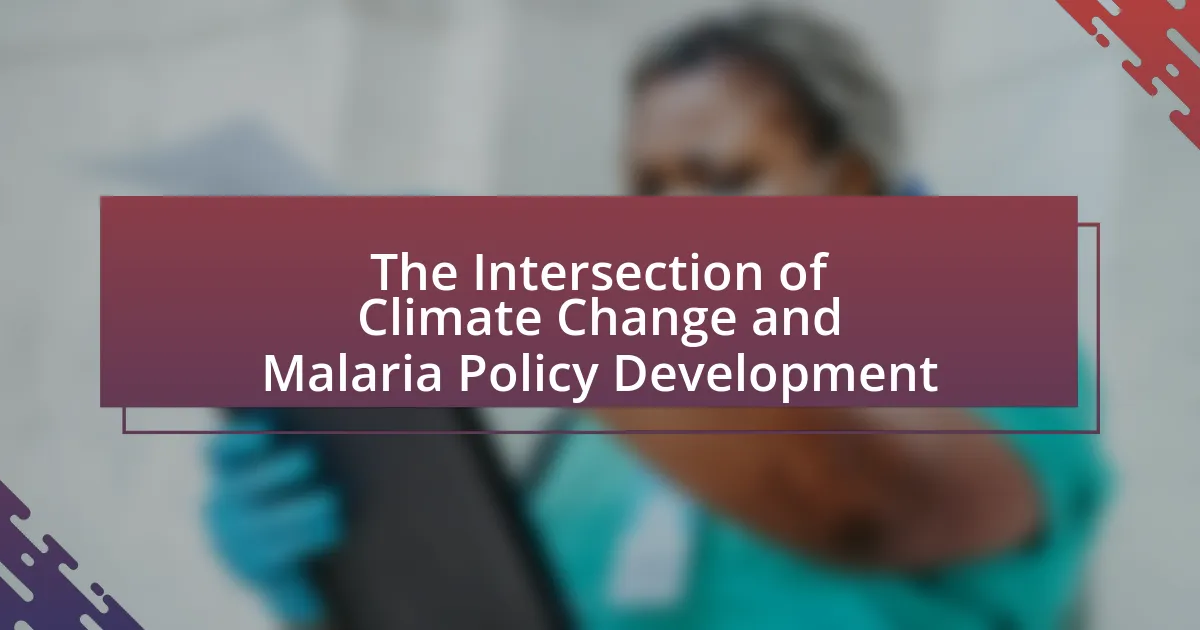Mobilizing Youth for Malaria Advocacy is an initiative focused on engaging young people in the fight against malaria through awareness, education, and action. The article outlines the importance of youth involvement in malaria advocacy, highlighting their unique perspectives and innovative approaches to communication, particularly through social media. It discusses key strategies for mobilizing youth, such as peer education and partnerships with organizations, while also addressing the challenges they face and the necessary support systems for effective engagement. Successful examples of youth-led initiatives and best practices for sustaining their involvement in malaria advocacy are also examined, demonstrating the significant impact young advocates can have on public health outcomes.
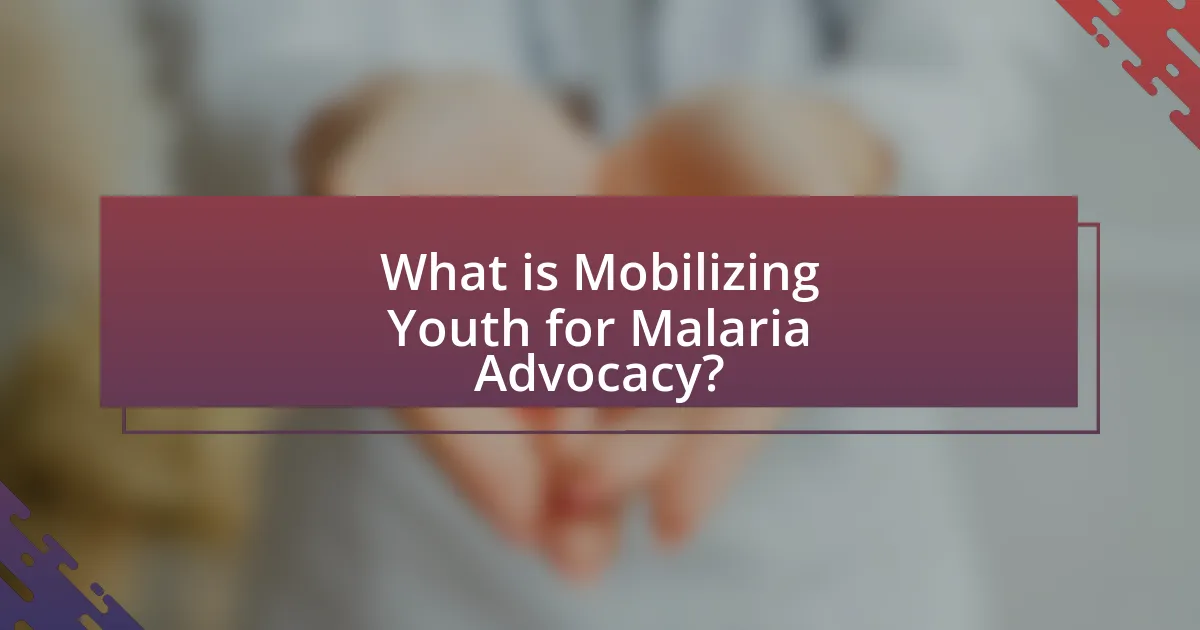
What is Mobilizing Youth for Malaria Advocacy?
Mobilizing Youth for Malaria Advocacy is an initiative aimed at engaging young people in efforts to combat malaria through awareness, education, and action. This movement empowers youth to become advocates for malaria prevention and control, leveraging their energy and creativity to influence policy and community practices. Evidence of its effectiveness can be seen in various programs that have successfully increased malaria awareness among young populations, leading to improved health outcomes in affected regions.
Why is youth involvement crucial in malaria advocacy?
Youth involvement is crucial in malaria advocacy because young people represent a significant demographic that can drive awareness and action against malaria. Their engagement fosters innovative approaches to communication and mobilization, leveraging social media and peer networks to spread information rapidly. For instance, the World Health Organization emphasizes that youth can effectively influence community behaviors and attitudes towards malaria prevention and treatment, as they often have the energy and creativity to engage their peers. Furthermore, studies show that youth-led initiatives have led to increased participation in malaria prevention programs, demonstrating their potential to enhance outreach and education efforts significantly.
What unique perspectives do young advocates bring to malaria issues?
Young advocates bring fresh, innovative perspectives to malaria issues by leveraging their unique understanding of social media and digital communication to raise awareness and mobilize action. Their familiarity with technology allows them to engage a broader audience, particularly their peers, through campaigns that resonate with younger generations. For instance, initiatives like the “Youth Against Malaria” campaign have successfully utilized platforms such as Instagram and TikTok to spread information and encourage preventive measures, demonstrating the effectiveness of youth-led advocacy in reaching diverse demographics. Additionally, young advocates often emphasize the importance of community involvement and grassroots solutions, which can lead to more sustainable and culturally relevant approaches to malaria prevention and treatment.
How can youth influence malaria policy and decision-making?
Youth can influence malaria policy and decision-making by actively participating in advocacy campaigns and engaging with policymakers. By leveraging social media platforms, youth can raise awareness about malaria issues, mobilize community support, and pressure governments to prioritize malaria prevention and treatment initiatives. For instance, organizations like the Global Fund have highlighted the role of youth in shaping health policies through initiatives that encourage young people to voice their concerns and propose solutions. Additionally, youth-led organizations can conduct research and present data-driven recommendations to stakeholders, thereby ensuring that their perspectives are considered in policy discussions.
What are the key strategies for mobilizing youth in malaria advocacy?
Key strategies for mobilizing youth in malaria advocacy include leveraging social media platforms, engaging in peer education, and fostering partnerships with youth-led organizations. Social media platforms, such as Instagram and Twitter, allow youth to share information and raise awareness about malaria prevention and treatment, reaching a broader audience quickly. Peer education initiatives empower young individuals to educate their peers about malaria, creating relatable and impactful messaging. Additionally, partnerships with youth-led organizations enhance resource sharing and amplify advocacy efforts, as seen in successful campaigns like the “Youth Against Malaria” initiative, which mobilized thousands of young advocates across Africa to promote malaria awareness and prevention strategies.
How can social media be leveraged for youth engagement in malaria advocacy?
Social media can be leveraged for youth engagement in malaria advocacy by creating interactive campaigns that encourage participation and sharing of information. Platforms like Instagram, Twitter, and TikTok allow for the dissemination of educational content, personal stories, and calls to action that resonate with younger audiences. For instance, the “Malaria Must Die” campaign effectively utilized social media to reach over 1 million young people, raising awareness and mobilizing them to advocate for malaria prevention measures. Engaging content, such as infographics and videos, can enhance understanding and foster community discussions, making youth feel empowered to contribute to the cause.
What role do educational programs play in mobilizing youth?
Educational programs play a crucial role in mobilizing youth by equipping them with knowledge and skills necessary for advocacy and action. These programs raise awareness about malaria, its prevention, and treatment, fostering a sense of responsibility among young people. For instance, initiatives like the “Youth Against Malaria” campaign have successfully engaged thousands of young individuals in community outreach and education efforts, leading to increased participation in malaria prevention activities. Research indicates that informed youth are more likely to advocate for health initiatives, demonstrating that educational programs effectively empower them to take action against malaria.
What challenges do youth face in malaria advocacy?
Youth face several challenges in malaria advocacy, including limited access to resources, lack of awareness, and insufficient representation in decision-making processes. Limited access to funding and educational materials hampers their ability to effectively engage in advocacy efforts. Additionally, many young people are not adequately informed about malaria’s impact and prevention strategies, which reduces their capacity to advocate effectively. Furthermore, youth often struggle to have their voices heard in policy discussions, as decision-making bodies may prioritize older, more established advocates. These challenges hinder the potential for youth-led initiatives to make a significant impact in malaria advocacy.
How can these challenges be overcome to enhance youth participation?
To enhance youth participation in malaria advocacy, challenges can be overcome by implementing targeted educational programs and leveraging social media platforms. Educational programs that focus on malaria awareness and prevention can empower youth with knowledge, making them more likely to engage in advocacy efforts. For instance, the World Health Organization reports that informed youth are more likely to participate in health initiatives, as they understand the impact of diseases like malaria on their communities. Additionally, utilizing social media allows for broader outreach and engagement, as platforms like Instagram and TikTok are popular among young people, facilitating the sharing of information and mobilizing collective action. Studies show that campaigns that effectively use social media can increase youth involvement by up to 40%, demonstrating the potential of these strategies to enhance participation.
What support systems are necessary for effective youth mobilization?
Effective youth mobilization requires structured support systems that include mentorship programs, access to resources, and community engagement initiatives. Mentorship programs provide guidance and skill development, enabling youth to effectively advocate for malaria awareness and prevention. Access to resources, such as funding, training materials, and technology, empowers youth to implement their initiatives successfully. Community engagement initiatives foster collaboration between youth and local organizations, enhancing the impact of their advocacy efforts. These support systems are essential for creating a sustainable framework that encourages active participation and leadership among young advocates in the fight against malaria.
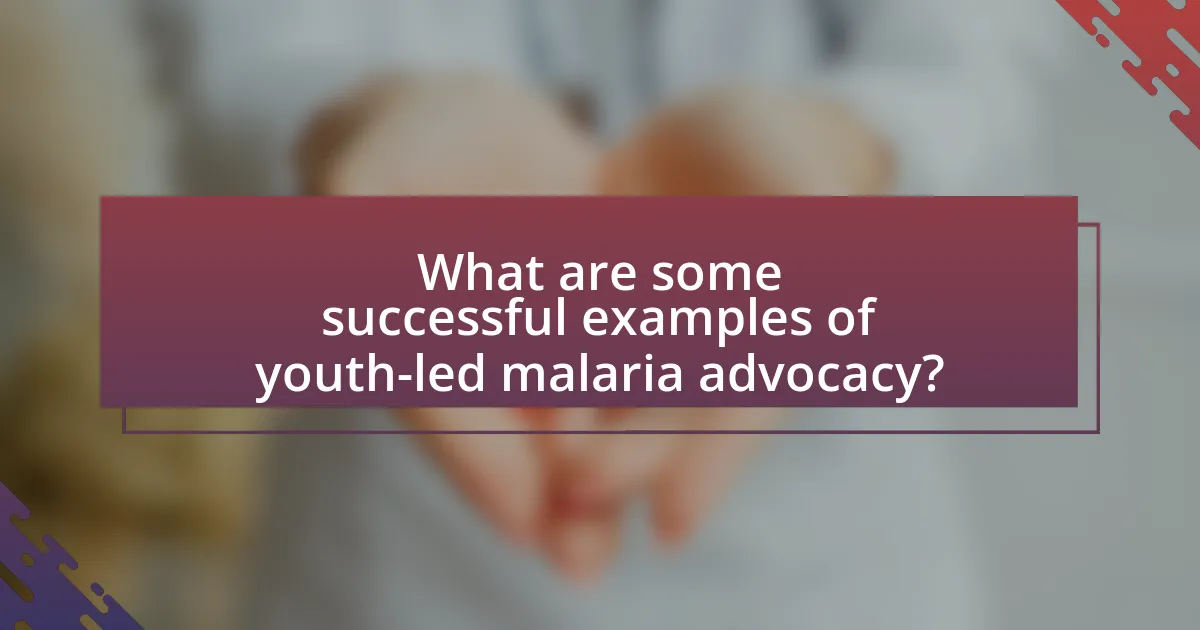
What are some successful examples of youth-led malaria advocacy?
Successful examples of youth-led malaria advocacy include the “Youth Against Malaria” campaign in Nigeria, which mobilized over 1,000 young people to raise awareness and distribute insecticide-treated bed nets, resulting in a significant increase in net usage in targeted communities. Another example is the “Malaria No More” initiative, where youth leaders in various African countries engaged in social media campaigns that reached millions, effectively educating their peers about malaria prevention and treatment. These initiatives demonstrate the impactful role of youth in malaria advocacy, evidenced by measurable improvements in community health outcomes and increased public engagement in malaria prevention efforts.
How have youth initiatives made a difference in malaria prevention?
Youth initiatives have significantly impacted malaria prevention by increasing awareness and mobilizing communities for action. These initiatives, often led by young people, utilize social media campaigns, educational programs, and community engagement to disseminate information about malaria prevention methods, such as the use of insecticide-treated bed nets and the importance of early diagnosis and treatment. For instance, the “Youth Against Malaria” campaign in Africa has successfully reached thousands of young individuals, resulting in increased bed net distribution and usage rates. Additionally, research indicates that youth-led initiatives can enhance local participation in malaria control efforts, leading to more sustainable health outcomes.
What specific campaigns have shown measurable success?
The “Nothing But Nets” campaign has shown measurable success in mobilizing youth for malaria advocacy. This initiative has distributed over 10 million bed nets in Africa, significantly reducing malaria incidence in targeted regions. A study published in the American Journal of Tropical Medicine and Hygiene indicated that the campaign contributed to a 50% decrease in malaria cases in areas where bed nets were distributed, demonstrating its effectiveness in combating the disease among vulnerable populations.
How can these success stories be replicated in other regions?
Success stories in malaria advocacy can be replicated in other regions by implementing tailored youth engagement strategies that focus on education, community involvement, and partnerships. For instance, regions can adopt successful models that involve training youth as malaria advocates, utilizing social media campaigns to raise awareness, and collaborating with local health organizations to ensure resources are effectively distributed. Evidence from initiatives like the “Youth Against Malaria” program in Nigeria shows that empowering young people to lead advocacy efforts significantly increases community awareness and participation, leading to improved health outcomes. By adapting these proven strategies to local contexts, regions can effectively mobilize youth and enhance malaria advocacy efforts.
What partnerships have proven effective in youth malaria advocacy?
Partnerships between youth organizations, governments, and international health agencies have proven effective in youth malaria advocacy. For instance, collaborations with the World Health Organization (WHO) and the Roll Back Malaria Partnership have facilitated youth-led initiatives that raise awareness and promote prevention strategies. These partnerships leverage resources and expertise, enabling youth advocates to engage in community outreach and educational campaigns, which have been shown to increase malaria awareness among young populations by up to 40% in targeted regions.
How do collaborations with NGOs enhance youth advocacy efforts?
Collaborations with NGOs enhance youth advocacy efforts by providing resources, expertise, and networks that amplify the voices of young advocates. NGOs often have established platforms and experience in mobilizing communities, which can significantly increase the reach and impact of youth-led initiatives. For instance, partnerships with organizations like the Global Fund or UNICEF have demonstrated that youth advocacy campaigns can gain traction through access to funding, training, and strategic guidance, leading to more effective outreach and engagement in public health issues such as malaria. These collaborations also foster a sense of legitimacy and credibility, encouraging more youth participation and support from stakeholders.
What role do governments play in supporting youth-led initiatives?
Governments play a crucial role in supporting youth-led initiatives by providing funding, resources, and policy frameworks that empower young leaders. For instance, many governments allocate specific budgets for youth programs, which can include grants for projects focused on public health issues like malaria advocacy. Additionally, governments often create partnerships with youth organizations to facilitate training and capacity-building workshops, enhancing the skills necessary for effective advocacy. According to the United Nations, countries that actively engage youth in decision-making processes see improved outcomes in health initiatives, demonstrating the effectiveness of government support in fostering youth-led efforts.
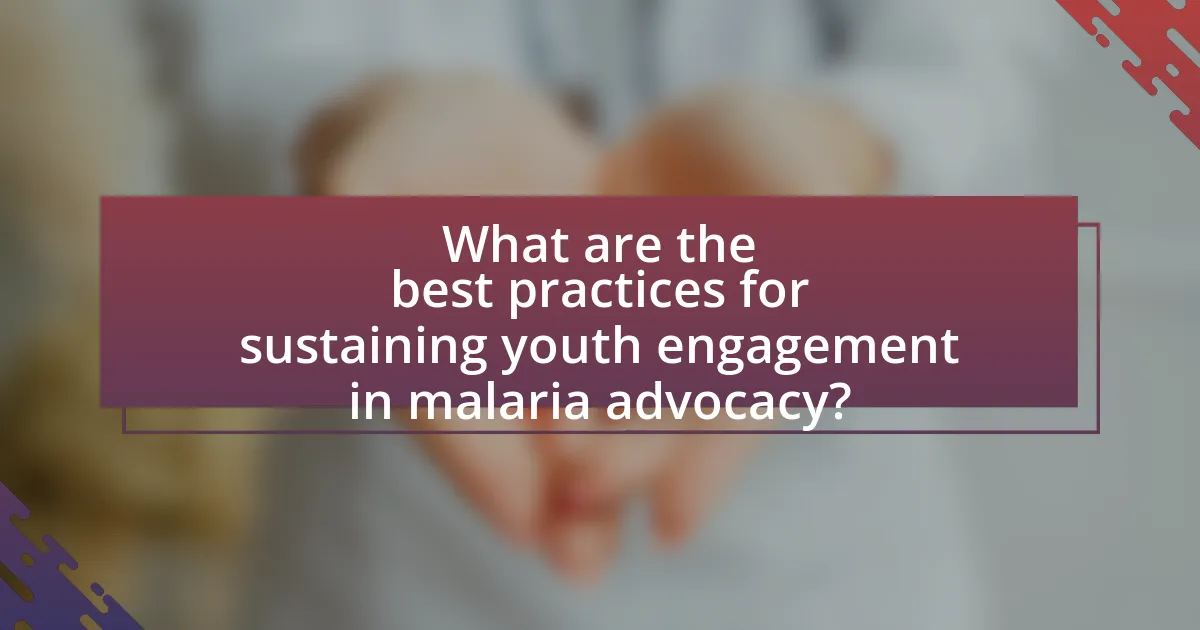
What are the best practices for sustaining youth engagement in malaria advocacy?
The best practices for sustaining youth engagement in malaria advocacy include fostering a sense of ownership, providing education and training, and creating platforms for youth voices. Fostering ownership involves involving young people in decision-making processes, which increases their commitment and motivation. Education and training equip youth with the necessary knowledge about malaria, enabling them to advocate effectively; for instance, programs like the Global Fund’s Youth Leadership Program have shown success in empowering young advocates. Creating platforms, such as social media campaigns and community events, allows youth to express their views and share their experiences, which enhances their engagement and visibility in the advocacy landscape.
How can ongoing education and training support youth advocates?
Ongoing education and training can significantly enhance the effectiveness of youth advocates by equipping them with essential knowledge and skills related to malaria advocacy. This continuous learning process ensures that youth advocates stay informed about the latest research, strategies, and best practices in malaria prevention and treatment. For instance, training programs can provide insights into effective communication techniques, enabling advocates to engage their peers and communities more persuasively. Additionally, education on policy frameworks and health systems can empower youth advocates to navigate and influence decision-making processes effectively. Studies have shown that well-trained advocates are more likely to mobilize community support and drive policy changes, ultimately contributing to improved health outcomes in malaria-endemic regions.
What resources are available for youth to stay informed about malaria issues?
Youth can stay informed about malaria issues through various resources, including online platforms, educational programs, and community initiatives. Websites such as the World Health Organization (WHO) and the Centers for Disease Control and Prevention (CDC) provide up-to-date information on malaria prevention, treatment, and statistics. Additionally, organizations like Malaria No More and the Roll Back Malaria Partnership offer educational materials and advocacy tools specifically designed for young people. Social media campaigns and youth-led initiatives also play a crucial role in disseminating information and engaging peers in malaria awareness efforts. These resources collectively empower youth to understand and advocate for malaria-related issues effectively.
How can mentorship programs foster long-term commitment among youth advocates?
Mentorship programs can foster long-term commitment among youth advocates by providing guidance, support, and a sense of belonging. These programs connect experienced advocates with youth, facilitating knowledge transfer and skill development essential for effective advocacy. Research indicates that mentorship enhances self-efficacy and motivation, which are critical for sustained engagement in advocacy efforts. For instance, a study published in the Journal of Youth Development found that youth involved in mentorship programs reported higher levels of commitment to their advocacy roles compared to those without mentorship. This structured support system not only empowers youth but also helps them navigate challenges, reinforcing their dedication to causes like malaria advocacy.
What practical tips can enhance youth involvement in malaria advocacy?
To enhance youth involvement in malaria advocacy, engaging them through education and awareness campaigns is essential. Providing training sessions on malaria prevention and treatment can empower youth to become informed advocates. Additionally, utilizing social media platforms allows young people to share information and mobilize their peers effectively; for instance, campaigns like “World Malaria Day” leverage social media to raise awareness among youth. Collaborating with local organizations can also create opportunities for youth to participate in community health initiatives, fostering a sense of ownership and responsibility. Statistics show that youth-led initiatives can significantly increase community engagement, as seen in programs where young advocates have successfully reduced malaria cases in their regions.
How can youth effectively communicate their message to a broader audience?
Youth can effectively communicate their message to a broader audience by utilizing social media platforms, engaging in community outreach, and collaborating with established organizations. Social media allows youth to reach diverse demographics quickly; for instance, platforms like Instagram and TikTok have millions of active users, enabling messages to spread rapidly. Community outreach initiatives, such as organizing local events or workshops, foster direct engagement and personal connections, enhancing message retention. Collaborating with established organizations provides credibility and access to larger networks, amplifying the youth’s voice in advocacy efforts. These strategies have been shown to increase awareness and mobilize support for causes like malaria advocacy, as evidenced by successful campaigns led by youth groups in various regions.
What strategies can youth use to mobilize their peers for advocacy efforts?
Youth can mobilize their peers for advocacy efforts by utilizing social media campaigns, organizing community events, and forming peer-led advocacy groups. Social media platforms allow youth to share information quickly and engage their peers through interactive content, such as videos and infographics, which can raise awareness about malaria and its impact. Organizing community events, such as workshops or awareness drives, fosters direct engagement and encourages participation, creating a sense of community around the cause. Additionally, forming peer-led advocacy groups empowers youth to take ownership of the advocacy efforts, enabling them to strategize and implement initiatives that resonate with their peers. These strategies have been effective in various youth-led campaigns, demonstrating the potential for collective action in addressing public health issues like malaria.
